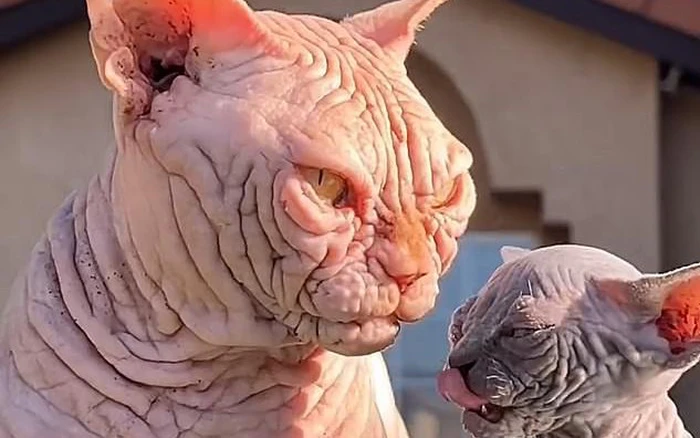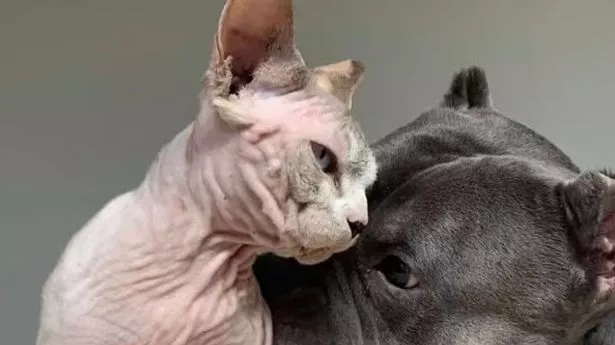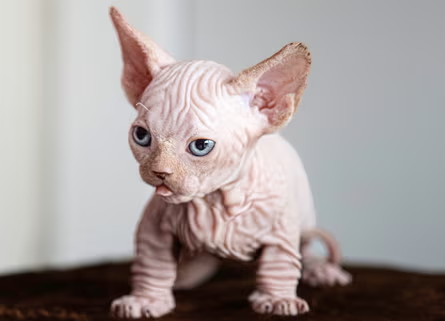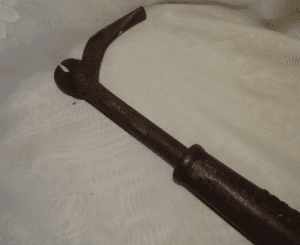The world of pet breeding has seen its fair share of controversies, but the latest development has shocked both animal lovers and welfare experts alike. The emergence of the “XL Bullycat”—a designer breed that mixes the traits of two extreme cat breeds—has ignited a heated debate about animal ethics, health, and welfare. This trend follows the recent legislative crackdown on XL Bully dogs in England and Wales, raising concerns that cats are now being bred to cater to extreme aesthetic demands, with little regard for their well-being.

What Exactly Is an ‘XL Bullycat’?
The so-called “XL Bullycat,” also nicknamed the “bullbino” on social media, is not a naturally occurring breed. It is an engineered cross between two distinctive cat breeds: the Sphynx, known for its hairless body, and the Munchkin, famous for its short legs. This combination results in a cat with excess skin folds and significantly shortened limbs, creating a bizarre and exaggerated appearance.
Why Are Breeders Creating XL Bullycats?
The trend for breeding these designer cats stems primarily from the influence of social media, where unusual and exotic-looking pets often attract massive attention. The goal of creating an “Instagram-worthy” pet has led to the rise of extreme breeds, despite the known health risks associated with their physical characteristics. Just like the XL Bully dog, the XL Bullycat is designed to turn heads—unfortunately, often at the expense of the animal’s health and happiness.
Health Implications for XL Bullycats
While the appearance of XL Bullycats may appeal to some, the health implications for these cats are severe and have sparked concern among veterinarians and animal welfare experts.
1. Shortened Limbs and Joint Strain
The Munchkin breed, known for its short legs, is prone to joint strain and mobility issues. When combined with the excess skin of the Sphynx, the XL Bullycat faces an even greater risk of painful arthritis and other orthopedic issues. According to Dr. Grace Carroll from Queen’s University Belfast, the combination of these traits means that these cats “face twice the number of challenges encountered by Sphynx and Munchkin breeds.”
2. Skin Problems and Infections
The excess skin folds in XL Bullycats are not just for show—they pose a significant risk of skin infections. Bacteria can easily thrive in the skin folds, leading to chronic skin conditions that require ongoing medical care. Dr. Dan O’Neill from the Royal Veterinary College emphasizes that these cats are likely to suffer from serious skin conditions, which can severely impact their quality of life.
3. Reduced Life Expectancy
The life expectancy of these cats is often shortened due to their engineered features. According to research from the RVC VetCompass program, the average lifespan of Sphynx cats is around 6.7 years, compared to 11.7 years for the average cat. Dr. O’Neill warns that XL Bullycats are likely to face similar or even shorter life spans, making them a high-risk choice for pet owners.
4. Lack of Natural Feline Behavior
Cats are naturally agile and love to climb, jump, and explore. However, the short legs and lack of whiskers (a common trait in Sphynx breeds) of XL Bullycats can limit their ability to engage in normal feline behaviors. A 2018 study from Utrecht University found that cats without whiskers face disadvantages in communication and spatial awareness, further complicating their interactions with their surroundings.
Why Animal Experts Are Alarmed
The rise of XL Bullycats has drawn comparisons to the recent popularity of XL Bully dogs, which led to new legislation in the UK aimed at regulating extreme breeding practices.
1. Ethical Concerns
Dr. Carroll and other animal experts warn that breeding for extreme traits often prioritizes aesthetics over animal welfare. This not only results in physical suffering but also raises ethical concerns about human manipulation of animals for superficial traits. “We should let cats be cats,” Dr. Carroll emphasizes, urging breeders to focus on the animal’s well-being rather than market demands.
2. Encouraging a Shift Toward Ethical Breeding
Animal experts are calling for a change in breeding practices, advocating for a focus on healthier and more natural feline characteristics. By refusing to support the purchase of cats with extreme physical traits, consumers can help discourage unethical breeding.
Dr. Carroll insists, “A shift toward ethical breeding could ensure that future cats are healthier, happier, and free to enjoy natural feline behavior like climbing, jumping, and lounging in the sun.”
What Can Pet Owners Do?
If you’re considering getting a cat, it’s essential to think about the animal’s long-term health and quality of life.

1. Adopt, Don’t Shop
The RSPCA and other animal welfare organizations strongly recommend adopting cats from shelters rather than purchasing them from breeders. Shelters are full of cats in need of loving homes, and adopting one can help save a life.
2. Avoid Extreme Breeds
Even if the exaggerated features of XL Bullycats or similar breeds might seem appealing, consider the health implications and ethical concerns. By choosing cats with more natural physical characteristics, you are more likely to end up with a healthier, happier pet.
3. Support Animal Welfare Campaigns
Organizations like the NatureWatch Foundation and Cats Protection are working to raise awareness about the risks of extreme breeding. Support their efforts by spreading the word and encouraging others to make informed decisions when choosing a pet.

Conclusion: Prioritizing Animal Welfare Over Aesthetics
The rise of the XL Bullycat is a concerning development in the world of pet breeding. While these cats might seem appealing to some, the severe health risks associated with their engineered traits are undeniable. Animal experts and welfare organizations agree that ethical breeding practices must take precedence over aesthetics to ensure the well-being of future generations of cats.
By understanding the implications of extreme breeding and making responsible choices as consumers, we can help promote healthier and more humane breeding standards. Let’s remember Dr. Carroll’s wise words: “We should let cats be cats.”


